Changing the Oil in an Early 911 Transmission
Or
If I
Can Change My Motor Oil, This should be Easy!
Harry Danberg
As part of routine maintenance on 911’s, changing the transmission oil is pretty high on the list. After all, this oil is the life-blood of your transmission and an unhappy transmission can make driving your car a terrible experience.
My car, a 1973 911T, has a "915" transmission. This is an upgrade from the original "901" transmission. The 901 Transmission has a race inspired "dogleg" first gear and then the H pattern for gears 2-5. The 915 Transmission is designed for a stronger engine and the shift pattern is the familiar H pattern for gears 1-4 that is seen on most cars. Both of these transmissions also feature a Porsche designed synchronizing system that works somewhat differently than what we see on most other cars. I am not an expert, so I can not explain the differences. I will say that the design requires a different timing for shifting than the more conventional systems.
Because of the unique synchronizing system, early 911 transmissions have lubrication requirements not seen in other manual transmissions. In conversations with experts, like Steve Weiner at Rennsport Systems, I have found out that SWEPCO 201 is the transmission oil of choice. The lubricating properties of this particular brand of oil allow the unique Porsche Synchronizers to work very smoothly.
Anyway, enough history.
To change your transmission oil, you will need the following:
- 3+ quarts transmission oil of your choice (most people get a 1 gallon container);
- A 5+ quart pan to catch the old oil;
- A hand oil pump or 3-4 feet of ¾" tubing and a funnel to refill the transmission;
- Wrench to remove the drain and fill plugs on the transmission. Depending on your transmission, you will need a 17 mm hex wrench (if your plugs are an "innie"), or an appropriately sized socket or wrench (if your plugs are an "outie"). Look and measure before you buy any tool;
- Car Jack and suitable jacking plates;
- 4 jack stands;
- Shop towels, kitty liter, etc to cleanup any spills;
- Eye protection (nothing worse than getting something in your eye when you are under a car); and
- Latex or Nitrile Gloves. They are optional but they make cleaning yourself afterwards a snap.
Drive your car for about 30 minutes to warm the oil in the transmission. Remember how your transmission feels.
Jack the car up so that it is even. You will need to use the four jack stands to do so. Figures 1 and 2 show how I supported my car. Once the car is on jack stands, push it sideways to convince yourself it will not fall off the stands when you are underneath the car yanking on your drain and fill plugs.
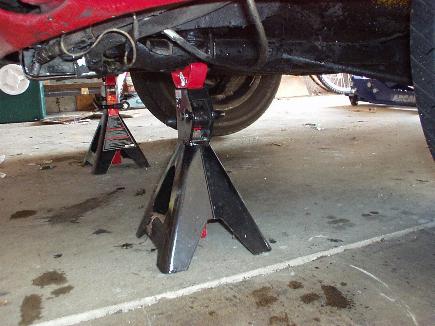
Figure 1
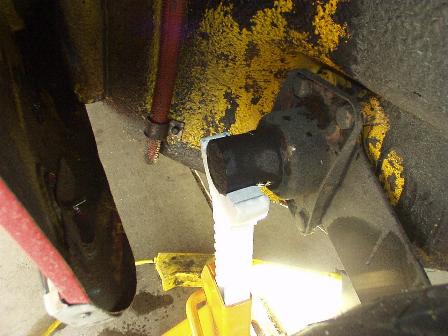
Figure 2
Take your new gear oil and put it in a pan of HOT water to help it flow more easily.
There are several ways to transfer the new oil, into the transmission. You can buy a small hand pump or do what I did, which is get a funnel and some ¾" tubing. Heat the end of the tubing to slip over the end of the funnel (Figure 3).

Figure 3
Get under the car. Place your drain pan under the transmission.
You want to remove the FILL plug FIRST. The reason for this is to avoid draining the oil only to discover you have no way to add oil to the transmission. Without oil in the transmission, you cannot roll the car or otherwise move it without a dolly.
If your plug is an outie, you just put the correct size wrench on the plug and pull (remember Righty tighty, Lefty loosey). If your plug is an innie, be sure to clean out all of the crud that is in the hole. Place your allen wrench in the hole and tap it in with a hammer to ensure it is fully seated. Once properly seated, turn and remove.
Once you have the fill plug removed, verify that the drain pan is under the drain plug and remove the plug. The oil will take what seems like ages to drain.
While the oil is draining, check the temperature of the fresh oil you are pre-warming in the pan of water. Warm it some more if needed.
Look at the drain plug. You should note that the drain plug is magnetic and will contain bits of metal from the transmission. The presence of fine filings is normal and not a reason to panic (Figure 4). However, if you see chunks of metal on the plug (Figure 5), these are usually pieces of the dog teeth in the synchronizers and indicate that you have a rebuild in your future.
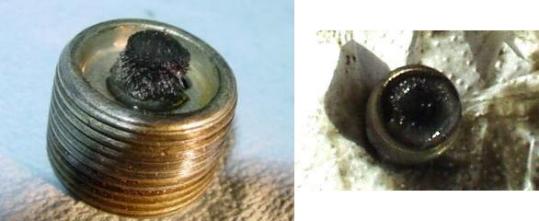
Figure 4
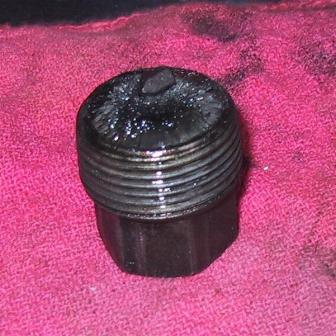
Figure 5
Clean the filings off of the plug(s).
Hopefully by now the transmission has drained. Leave the drain pan under the transmission.
Once drained, put a bit of anti-seize on the drain plug and replace it. You do not need to tighten it very much (18 ft-lbs is sufficient) as the system is not under any great pressure.
We are now ready to refill the transmission. Insert the end of the fill hose into the fill hole in the transmission (Figure 6). If it is a pump, put the business end of the pump into the bottle of new oil and pump. If you are using the funnel method, hold the funnel above the fill hole and pour the oil into the funnel. Continue adding until you have added about 3 quarts. You will know when the transmission is full when you see oil coming out the fill hole. When it stops running out, you can now reinsert the fill plug (coat it with anti-seize also) and tighten.
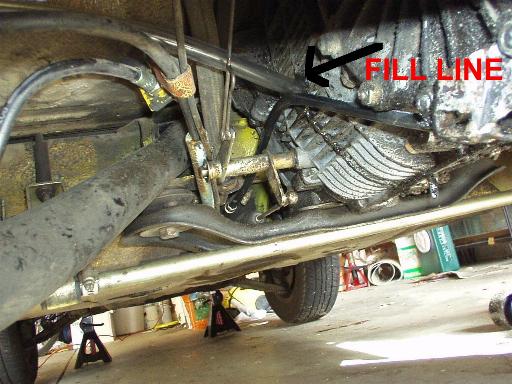
Figure 6
While the car is up in the air, this is good time to lubricate any moving parts underneath the car like the throttle linkage and clutch mechanism.
Once you are done filling and lubricating, lower the car. Put your used oil in containers for recycling. Startup your car and move it away from your work area. Clean up any spilled oil.
Clean yourself up and take you car for a well-earned ride. Note the shifting improvements.
I wish to thank Steve Weiner at Rennsport Systems and the folks at the Pelican BBS for their help and advice. I also want to thank my wife, Stephanie, for her patience in letting me track oil into the house and taking the pictures.
© 2004 All rights Reserved - Harry Danberg